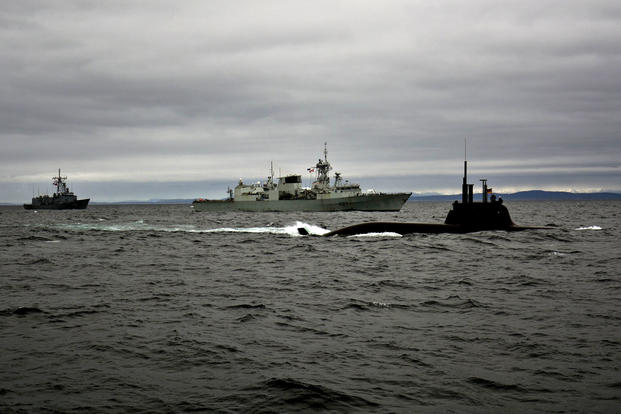More than 2,000 service members from 10 NATO countries practiced hunting for stealthy submarines off the coast of Norway, as Russia rapidly increases its deep-sea activities around the world.
U.S. sailors took to the skies to search for submarines during Exercise Dynamic Mongoose, which wrapped up just days before this week's NATO summit. Twenty American sailors from Patrol Squadron 10 participated in the anti-submarine warfare exercise, along with a Navy P-8A Poseidon maritime-patrol aircraft.
The sailors joined service members from Canada, Denmark, France, Germany, the Netherlands, Norway, Spain, Turkey and the United Kingdom during the 12-day exercise. There were two submarines, seven ships and three maritime-patrol aircraft involved. The sailors faced a series of scenarios that rapidly got more complex, utilizing multiple surface and air units, said Navy Lt. Fiona McCoy, the VP-10 detachment's officer in charge.
"This year's exercise [challenged] the participating units from very early on, encouraging focused training in task group-level tactics," she said.
That kind of training is essential as Russia invests in quiet new submarines that are incredibly difficult to detect, said retired Lt. Cmdr. Tom Callender, who spent two decades in the U.S. Navy as a submarine officer.
The Russians aren't just operating in the Black or Baltic seas, he said. They're pushing into the Mediterranean and Atlantic too.
"We need to really test our sailors, our warfighters, on those high-end skills that we haven't been using over the last 20 years," said Callender, who now serves as a senior research fellow for defense programs at the conservative Heritage Foundation. "Most of the young sailors ... had never tracked a real-live submarine before. There hasn't been a lot of real-world experience that we had during the Cold War."
Russia is believed to have conducted more submarine deployments over the last three years than it did over more than two decades following the end of the Cold War, he said.
The head of NATO warned in December that the country's submarine buildup could threaten vital communication lines between North America and Europe. Troops out on deployment or patrol need to know how they can better spot whether the Russians are taking steps to map out the vital undersea communication cables, Callender said.
No single military can combat global threats alone, McCoy said, which is why training together during exercises like Dynamic Mongoose is so important.
"We can continue to build our combined capability to rapidly respond to any emerging regional threat," she said. "The U.S. Navy shares the maritime environment with many countries and operates in a safe and professional manner according to established international law.
"We expect that others will conduct themselves in a similar manner," McCoy added.
Dynamic Mongoose wasn't the only NATO anti-submarine exercise this year. About 5,000 service members from 22 partner nations participated in Baltic Operations 2018 earlier this year. That exercise included 60 aircraft, 42 ships and a submarine.
NATO also led Dynamic Manta 2018, an exercise in the Mediterranean Sea that focused on enhancing combined anti-submarine and anti-surface warfare capabilities.
Callender said NATO and bilateral exercises could become even more common as Russia invests in new capabilities. Sailors have spent a lot of time in the Persian Gulf in recent years, which is warm and relatively shallow. The ocean changes a lot when waters turn cold and rough, he said.
"It's very critical to invigorate this type of training," he added. "I think we need to make it part of the process in addition to the normal deployments to the Gulf and other places. This is critical training for our sailors."
-- Gina Harkins can be reached at gina.harkins@military.com. Follow her on Twitter at @ginaaharkins.












